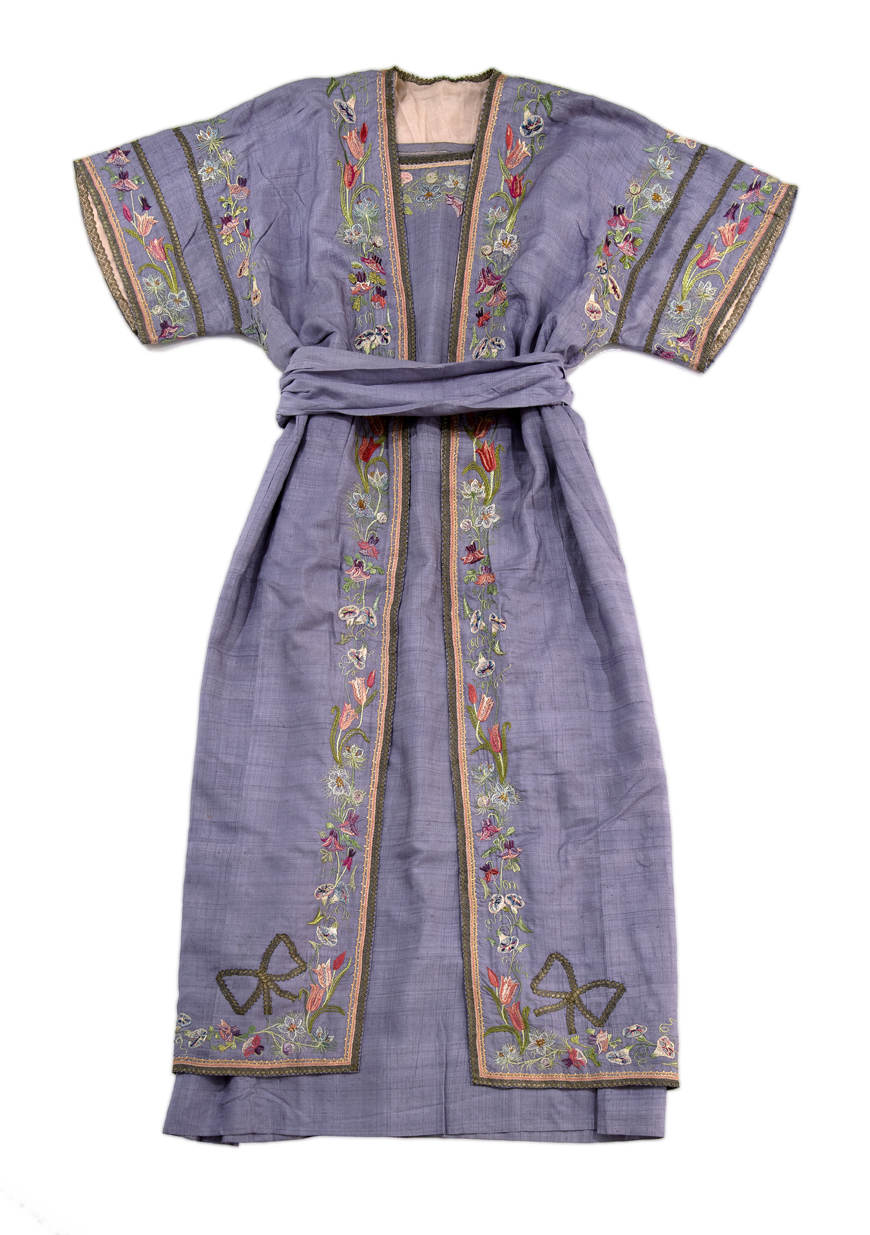Early this spring, I enjoyed leading two Inside Look discussions at the Delaware Art Museum on Marie Spartali Stillman’s embroidered tunic and shoes. The textile pairing is included in the museum exhibition, Collecting and Connecting, Recent Acquisitions, 2010-2020, and displayed in a section that prompts visual dialogues on dressing and clothing. Due to the pandemic, I led the talks on Zoom, and the online format led to fascinating discussions on the Pre-Raphaelites, the artist’s family history, and the Aesthetic Movement.
The British artist Marie Spartali Stillman (1844-1927) designed this matching embroidered tunic and shoes and decorated the garments with cascading floral designs. Though undated, the ensemble is likely from the late nineteenth century and perhaps created for her daughter Effie upon her marriage in 1905. Stillman created a mix of floral designs, including tulips, clovers, and morning glories. In a sense, Stillman fabricated a still life on the garment and shoes to decorate the body of the wearer. With her focus upon florals and the natural world, she references the Pre-Raphaelite aesthetic and the practice of depicting the natural world through close looking. The British art critic John Ruskin, ardent supporter of the Pre-Raphaelites, advocated truth to nature, specifically equating beauty and spirit to the natural world. Our discussion group was particularly intrigued with the Victorian language of flowers and the possible meanings Stillman attached to each floral pairing. We started to consider the morning glories and love-in-a-mist, a selection attached to symbols of love and possibly a reference to her daughter’s impending marriage. In light of Stillman’s Pre-Raphaelite ties, our group also started to parse out how the fashionable ensemble could reflect early Renaissance aesthetics studied by the artists, such as Botticelli paintings celebrating spring and Italian poetry. Moreover, we connected how the tunic reflected the Aesthetic Movement belief in improving life by surrounding oneself with beauty, reflected in the embroidery design or silk.
Participants began observing Stillman’s relationships with other Pre-Raphaelite artists, including Dante Gabriel Rossetti and Ford Madox Brown. Our discussion group included descendants of the artist, who offered insights into Stillman’s family and their dedication as patrons of the art. The conversation benefitted from the intimate anecdotes on the Spartalis interest in horticulture and gardening, and of the artist’s surviving collection of embroidery and silk. Stillman became closely connected to a mid-nineteenth century artistic milieu, and eventually married the painter and journalist William James Stillman to enter the transatlantic art world of the Aesthetic Movement. As a group, we considered the tunic and shoes in the larger framework of a bohemian circle in Britain in the mid-nineteenth century and the style of the dress. Compared to the structure of women’s garments in the Victorian era, the tunic is reminiscent of “artistic” dress of the period with the freeing silhouette. The group even mentioned how the tunic’s sleeves and construction appeared similar to Japanese kimonos, perhaps a reference to Stillman’s connection with the expatriate painter James McNeil Whistler and the emerging Japonisme among European artists as they grew increasingly inspired by Japanese art and design.

As we continued to examine the tunic, participants discussed female artists working in the Victorian era and their degree of access to art academies and exhibition opportunities. Most women in the nineteenth century, like Stillman, would have been taught needlework skills. The tunic and embroidery raise questions on how definitions of gender have become attached to different artistic mediums and materials during the nineteenth century, or what was traditionally deemed appropriate for women. Stillman has often been overshadowed by a Pre-Raphaelite circle narrative dominated by men, or labeled as an amateur artist due to her focus on watercolors and embroidery. Our discussion raised important questions about how to rewrite narratives in a museum, or who gets included within the galleries themselves to present an inclusive art history.
Stillman also worked alongside William Morris’s wife, Jane, and shared summers at Kelmscott Manor in the Cotswolds in southern England. We compared the wildflower designs on the ensemble to Morris’s embroidery and considered the possible collaborations between the two artists. The floral designs perhaps reference visits to Kelmscott Manor and the gardens, seen in Stillman’s own watercolors of the residence. Participants also noted the Pre-Raphaelite interest in reviving craft and return to handwork, such as the attention to decorating and furnishing interiors with artistic beauty. This artistic circle became passionate about decoration’s role in providing aesthetic pleasure and the spiritual benefits of beauty, seen with a wearable ensemble. Discussing Stillman’s embroidered tunic and shoes, we began to understand her central role in Victorian artistic circles and her vision in capturing Pre-Raphaelite beauty.
Lea C. Stephenson
PhD student in Art History at the University of Delaware
Inside Look is a collaboration between the Delaware Art Museum and the University of Delaware’s Department of Art History and Community Engagement Initiative.
Our next Inside Look discussions are scheduled for September 24 & 26, 2021. Join us!
Top to bottom: Embroidered Shoes, not dated. Marie Spartali Stillman (1844–1927). Embroidery on silk, each: 4 1/2 × 3 × 10 1/2 inches. Delaware Art Museum, Gift of Eugenia Diehl Pell, 2016. | Embroidered Tunic, not dated. Marie Spartali Stillman (1844–1927). Embroidery on silk, 53 × 19 inches. Delaware Art Museum, Gift of Eugenia Diehl Pell, 2016.


